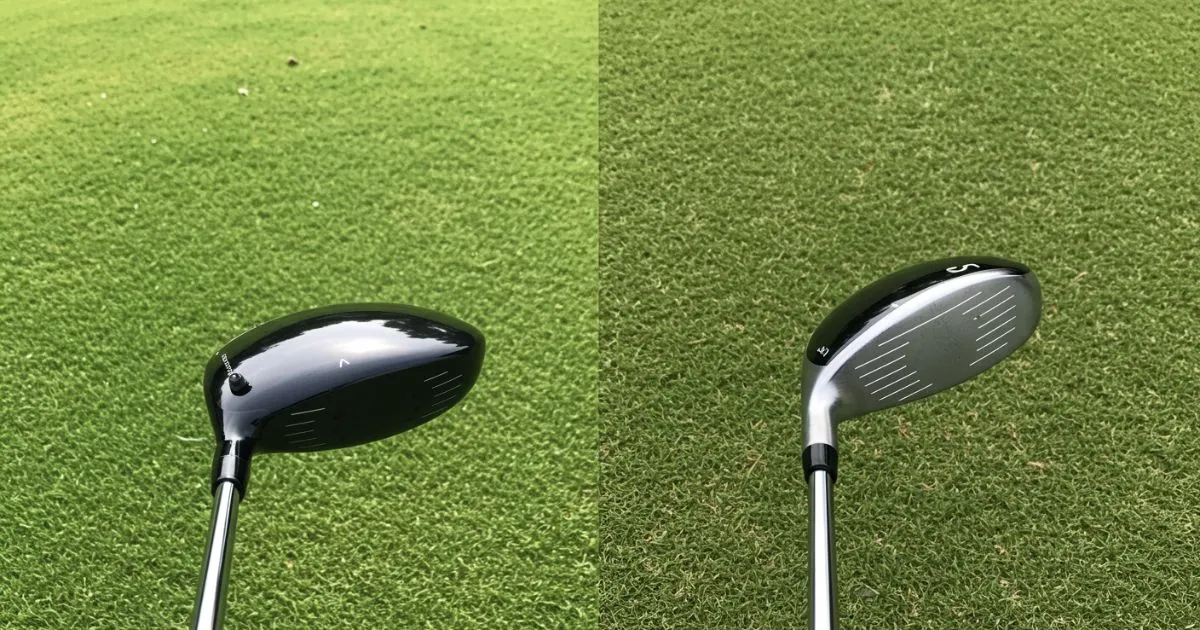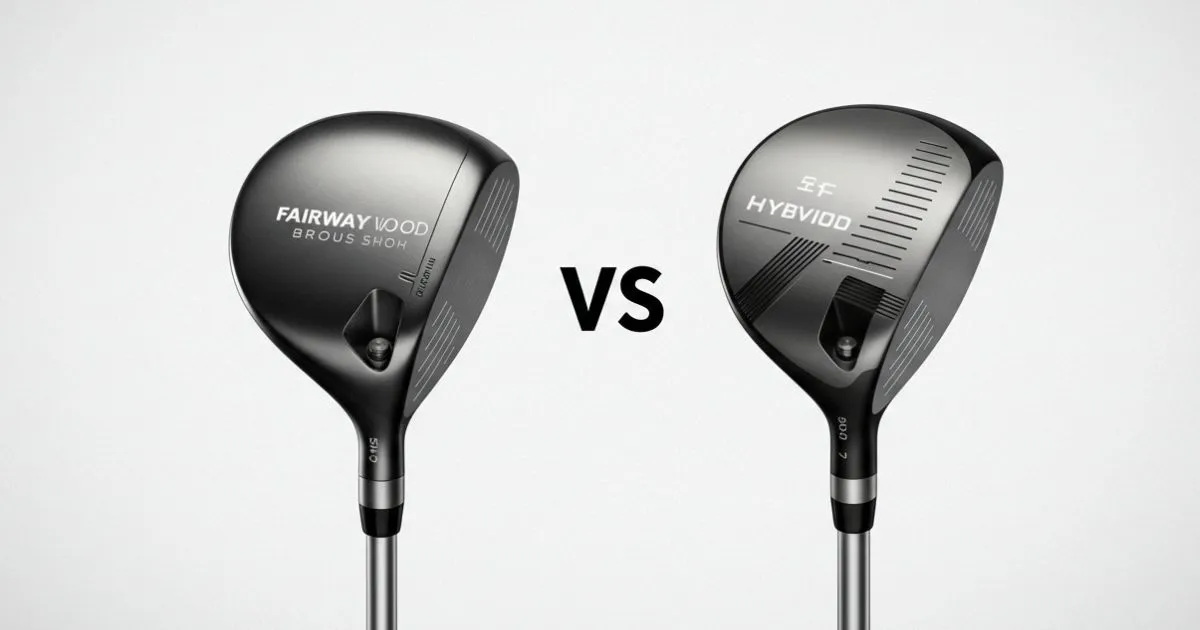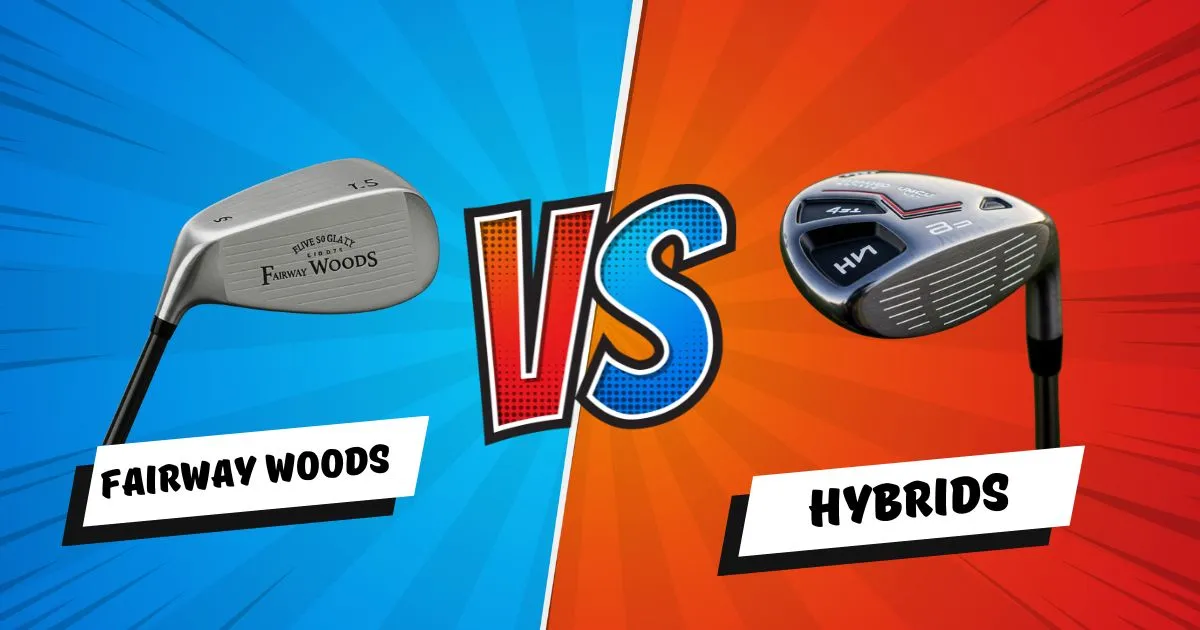Golf can feel like a puzzle sometimes, especially when you’re standing in the shop staring at rows of clubs, wondering which ones will actually help your game. If you’ve ever debated between a fairway wood and a hybrid, you’re not alone. These two types of clubs often spark confusion among beginners and seasoned players alike. Should you grab a 3-wood or a 3 hybrid? What about a 5-wood versus a 4 hybrid? I’ve been there, and after years of tinkering with my bag (and a few too many shanked shots), I’ve got some thoughts to share.
In this guide, we’ll break it all down—fairway woods vs hybrids, their differences, pros and cons, and when to use each. I’ll throw in my own experiences, a handy comparison chart, and even some distance insights to help you decide. Whether you’re new to golf or just looking to fine-tune your setup, let’s figure out what’s best for your swing.
Should I Pick a Fairway Wood or a Hybrid?
The big question: fairway wood or hybrid? It’s not a one-size-fits-all answer—it depends on your game, your swing, and what you’re trying to achieve on the course. Let’s make it simple with a quick rundown.

Try a Fairway Wood If:
- You’re confident hitting off the tee and want max distance—like with a 3 fairway wood golf club or a taylormade stealth 2 3 wood.
- You love the feel of a traditional wood and don’t mind a slightly bigger clubhead.
- You’ve got a faster swing speed and can handle the lower loft, like the 3 wood loft (typically 15-18 degrees).
- You’re aiming for long, soaring shots that roll out, especially on wide-open fairways.
Try a Hybrid If:
- You struggle with consistency and need forgiveness—like with a 3 hybrid or stealth 2 hybrid.
- You’re replacing long irons (think 3 iron hybrid) and want an easier launch.
- You often play from tricky lies—rough, divots, or tight spots—where a hybrid club distance chart shows its versatility.
- You prefer a compact head that feels more like an iron but performs like a wood.
I remember my first 3-wood—a callaway xhot 3 wood—and how I thought it’d turn me into a distance machine. Spoiler: It didn’t. I topped it more than I’d like to admit. Then I tried a 3 hybrid, and suddenly, I was getting the ball airborne without a prayer to the golf gods. Your mileage may vary, but let’s dig deeper into why that might be.
My Experience
Golf’s a personal journey, right? For me, choosing between fairway woods and hybrids came down to trial and error. I started with a ping 3 wood because I loved the idea of crushing long shots off the tee. It worked great when I caught it flush, but on off-days (or off-tees), it was a disaster—low hooks and thin shots galore.
Then I borrowed a buddy’s 2 hybrid golf club. Night and day. The smaller head felt less intimidating, and I could hit it from the fairway, rough, even a sketchy lie near a bunker. It wasn’t as long as my 3-wood, but it was way more reliable. Now, my bag’s got a 5-wood and a 4-hybrid, and I mix and match depending on the course. Spoiler alert: I still keep a taylormade burner wood 3 in the garage for nostalgia.
If you have a smooth swing, you might prefer a stealth 2 3 wood. If you want more control, try a tsr2 3 hybrid. Let’s unpack the differences so you can find your fit.
What’s the Difference Between a Hybrid and a Fairway Wood?

At first glance, hybrids and fairway woods might look like cousins, but they’re built for different jobs. Here’s the scoop:
Clubhead Size: Fairway woods—like a mavrik 3 wood or pxg 3 wood—have larger, rounded heads. Hybrids, like a callaway edge 3 hybrid, are smaller and more iron-like.
Loft: Fairway woods usually have less loft (3 wood degree loft is around 15-18°), while hybrids pack more (3 hybrid loft often sits at 19-21°).
Shaft Length: Woods have longer shafts for extra swing speed (think taylormade 3 fairway wood), while hybrids are shorter, offering control (like a nike 3 hybrid).
Design Purpose: Fairway woods chase distance; hybrids prioritize forgiveness and versatility.
Imagine this: A 3-wood is like a smaller version of a big driver. A 3 hybrid is a mix of an iron and a wood. It is small but strong. That’s the core difference between woods and hybrids.
Fairway Wood Pros & Cons
Let’s weigh the good and bad of fairway woods. They’ve got their fans (me included, sometimes), but they’re not perfect.
Pros
- Distance: A 3 wood distance chart shows they go far—200-240 yards for most amateurs with a solid swing.
- Versatility: Great off the tee or fairway—think taylormade stealth 2 3 wood or tsr3 3 wood.
- Roll-Out: Lower loft means more run, perfect for firm courses.
- Feel: That satisfying “thwack” off a m6 3 wood or callaway maverick 3 wood is hard to beat.
Cons
- Harder to Hit: Bigger heads and longer shafts (like a taylormade 300 series 3 wood) demand precision.
- Less Forgiving: Mishits with a 3hl wood or strata 3 wood often go sideways.
- Rough Struggles: Tough to escape thick grass compared to hybrids.
I’ve had days where my 7 fairway wood felt like a magic wand, sailing the ball 180 yards straight down the fairway. Then there were days it betrayed me, sending a weak slice into the trees. It’s a trade-off—power for precision.
Hybrid Pros & Cons
Now, let’s flip to hybrids. These clubs have saved my bacon more times than I can count.
Pros
- Forgiveness: Mishits with a 3 hybrid distance (say, 180-210 yards) still get decent results.
- Easy Launch: Higher loft—like a 4 hybrid loft—pops the ball up effortlessly.
- Versatility: From rough to fairway, a stealth hybrid 3 or tsr 3 hybrid shines.
- Compact Feel: Feels like an iron but performs like a wood—perfect for a 2 hybrid vs 3 wood debate.
Cons
- Less Distance: A hybrid vs wood distance chart shows they lag behind woods by 10-20 yards.
- Limited Roll: Higher trajectory means less run-out on firm ground.
- Looks: Some golfers (not me!) find hybrids less “cool” than a sleek pxg fairway wood.
My callaway xr 4 hybrid is my go-to when I’m stuck in the rough. It’s not as sexy as my sim ti 3 wood, but it gets the job done without drama.
Fairway Woods vs Hybrids Comparison Chart
This chart compares fairway wood and hybrid distances for different swing speeds. Real-world results will depend on your swing, club specs, and contact quality—but it’s a helpful starting point!
| 60 | 70 | 80 | 90LPGA | 100 | 110PGA | 120 | 130 | 140 | |
| Driver (total) | 155 | 181 | 206 | 232 | 258 | 284 | 310 | 335 | 361 |
| Driver (carry) | 144 | 168 | 192 | 216 | 240 | 264 | 288 | 312 | 336 |
| 3 Wood | 130 | 152 | 174 | 195 | 217 | 239 | 260 | 282 | 304 |
| 2 Hybrid | 128 | 150 | 170 | 190 | 209 | 232 | 252 | 274 | 292 |
| 5 Wood | 123 | 144 | 164 | 185 | 205 | 226 | 246 | 267 | 288 |
| 3 Hybrid | 121 | 142 | 163 | 182 | 201 | 221 | 242 | 262 | 281 |
| 7 Wood | 115 | 134 | 156 | 173 | 192 | 211 | 232 | 250 | 269 |
| 4 Hybrid | 114 | 133 | 154 | 171 | 191 | 208 | 231 | 248 | 268 |
Tip: When picking golf clubs, make sure the distances between them (gapping) are right. Since you can only carry 14 clubs, avoid having two that do the same job. A club fitting in-store can help check that your set works perfectly for you.
Hybrid Equivalent Clubs
Here’s a simple guide to the most common club equivalents for hybrids and fairway woods. These can differ a bit depending on the brand. Remember that not all of these clubs are standard. You may need to place a custom order for some. The hybrids 3-5 and fairway woods 3, 5, and 7 are the most common ones you will see.
| Loft | Equivalent Wood | Equivalent Iron | |
|---|---|---|---|
| 1 Hybrid | 14-16° | 3 Wood | 1 Iron |
| 2 Hybrid | 17-19° | 4 Wood | 2 Iron |
| 3 Hybrid | 19-21° | 5 Wood | 3 Iron |
| 4 Hybrid | 22-24° | 7 Wood | 4 Iron |
| 5 Hybrid | 25-27° | 9 Wood | 5 Iron |
| 6 Hybrid | 29-31° | 11 Wood | 6 Iron |
| 7 Hybrid | 32-24° | 13 Wood | 7 Iron |
For example, a 7 wood vs 4 hybrid debate? The 7 wood degree loft (around 21°) is close to a 4 hybrid, but the wood might edge out slightly in distance.
Hybrids and Fairway Woods vs Irons
If you’re a skilled golfer, you’ll likely find irons easier to control than these other clubs. You can shape your shots—left, right, high, or low—more effectively with irons. But if you don’t hit the ball right in the center and compress it well, irons aren’t as forgiving.
Why choose a hybrid or fairway wood over an iron? Simple: They’re easier to hit. A 3 iron hybrid goes higher than a regular 3-iron. A 5-wood hits farther than a 5-iron with less effort. Check a hybrid vs irons chart—hybrids bridge the gap between woods and irons, while fairway woods lean toward raw power.
I suggest sticking with irons until you notice your shots getting less consistent. When that happens, swap out that iron and any lower ones for woods or hybrids. For example, I switched my 4 iron for a 7 wood because my distance stays steadier with woods from that point on.
3-Wood vs 3-Hybrid
The classic showdown: 3 wood vs 3 hybrid. A 3-wood (like a taylormade fairway wood 3) is your distance champ—think 220 yards off the tee with a good swing. A 3 hybrid (say, an adams golf hybrid 3) trades some of that distance (around 200 yards) for control and forgiveness. I lean toward the hybrid when accuracy matters more than bombing it.
5-Wood vs 3-Hybrid
Next up: 5 wood vs 3 hybrid. A 5-wood (like a fairway wood 5 vs hybrid) might give you 190-210 yards with a 18-20° loft, while a 3 hybrid keeps it tighter at 180-200 yards. The 5 wood distance vs 3 hybrid edge goes to the wood, but the hybrid’s easier to hit from tough spots.
7-Wood vs 4-Hybrid
Finally, 7 wood vs 4 hybrid. A 7 wood distance chart pegs it at 170-190 yards, slightly longer than a 4 hybrid distance chart (160-180 yards). I love my 7 wood hybrid equivalent for its soft landing on greens, but the 4-hybrid wins in the rough.
Wrapping It Up
So, fairway woods vs hybrids—which wins? Neither—they’re tools for different jobs. If you crave distance and confidence off the tee, grab a 3 wood or 5-wood. If you want forgiveness and versatility, a 3 hybrid or 4-hybrid might be your new best friend. Test them out—borrow a taylormade stealth 2 3 wood or a callaway edge 4 hybrid from a friend—and see what clicks.
Golf’s about finding what works for you. My bag’s a mix of both, and I wouldn’t have it any other way. What’s your pick? Let me know—I’d love to hear how it goes!


